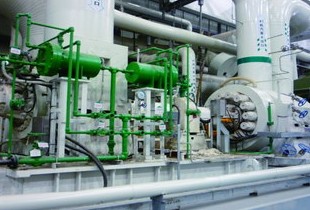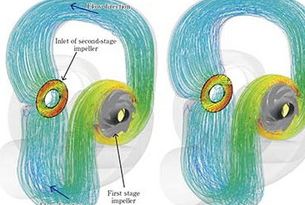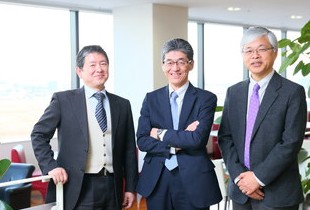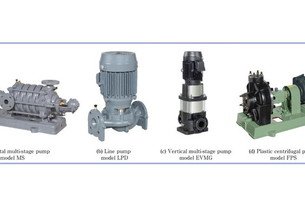Issue No. 254〔Delivered Products & Systems〕
Delivery of Municipal Waste Treatment Plant for Musashino City
– a Waste Incineration Plant with a Diverse Variety of Functions –
Author
Mitsutoshi YAMAMOTO*
Fumio SATO*
Takashi MIYASAKA*
Koichi SATO*
Masaaki EZAWA*
Yuki KOBAYASHI*
- *
Ebara Environmental Plant Co., Ltd.
EBARA constructed and completed a municipal waste treatment plant for Musashino City at the end of March 2017. The plant combines the basic functions of a waste incineration plant with a diverse variety of other functions, including, under a concept designated by the city, heat and electric power supply to nearby facilities both under normal circumstances and in the event of a disaster. In addition to all of these functions, its architectural design is harmonious with the surrounding scenery and it offers further hospitable services for visitors. Because the plant had to be constructed on a small site adjacent to existing facilities, another feature it offers is its compact size, which was achieved by adopting processes that are simple but able to meet very strict exhaust control values, by installing the incinerator, platform, and other facilities underground. The dry exhaust treatment process using sodium bicarbonate has achieved operation with 8 ppm or less of hydrogen chloride, which was the range previously covered by wet exhaust treatment processes.
Keywords: Waste incineration, Disaster prevention, Seismic design, Cogeneration system, Energy supply, Low air ratio combustion, Sodium bicarbonate, High efficiency power generation
1. Introduction
Recently, waste treatment plants have had to address a wide spectrum of needs in addition to hygienic and efficient waste treatment, such as recycling of waste, effective use of combustion waste heat, and contributing to the community. Since the Great East Japan Earthquake, it has become important for waste treatment plants to play roles in the continuity of waste treatment in the event of a disaster and contributing to community disaster prevention measures.
In the New Musashino Clean Center (tentative name) Construction and Operation Project, Musashino City has requested that constructors advance proposals emphasizing the construction of waste treatment plants with the following characteristics: harmony with the landscape and architectural design, consideration for the local community and daily life, disaster resistance, and safety and security in consideration of environmental conservation. Ebara proposed a specific idea based on the city’s policy, and was contracted to construct the waste treatment plant and provide operation services for 20 years. We completed the construction of the waste treatment plant building in March 2017, and began the operation of the Musashino Clean Center. The next section gives an overview of the waste treatment plant and describes its features.
2. Overview of the Project
2.1 Overview of the project
An overview of the project is shown in Table 1. The construction work is for a new waste treatment plant on the existing adjacent site in place of the existing Clean Center, which is Musashino City’s only municipal waste treatment plant. For the construction of the new waste treatment plant, citizens participated in the decision-making process for the site, basic plan, and concept of the waste treatment plant. The project uses a DBO contract, which means a package contract of design, building, and operation.
| Project name | New Musashino Clean Center (tentative name) Construction and Operation Project |
| Project contract type | DBO contract (package contract of design, building, and 20 years of operation) |
| Plant construction period | period July 2013 to June 2019 Plant building: Completed in March 2017 Office building: Scheduled to be completed in June 2019 |
| Client | Musashino City |
| Constructor | [Representative company]Ebara Environmental Plant Co., Ltd. [Constituent company] Kajima Corporation |
| Operator | Musashino E Service Co., Ltd. (special purpose company) |
2.2 Overview of units
An overview of the major units of the waste treatment plant is shown in Table 2. The general flow of the units of the waste treatment plant is shown in Figure 1.
Waste is carried into the waste treatment plant and then loaded from the platform into the waste pit, stored and stirred there, and loaded into the incinerator by the waste crane. The loaded waste is combusted in the incinerator.
The exhaust gas produced by this combustion is subjected to heat recovery in the boiler and further cooled by the economizer. Dust, hydrogen chloride, sulfur oxides, dioxins, etc. are removed by the dust collector. In the waste treatment plant, an exhaust gas recirculation line is installed to branch some of the exhaust gas from which hazardous substances were removed and return it to the incinerator.
The bottom ash discharged from the incinerator is subjected to removal of ferrous and nonferrous metals, etc. in the ash separation equipment, then humidified, stored in the ash pit, and carried out to the eco-cement plant for use.
Fly ash, on the other hand, is collected by the dust collector, transported to the fly ash reservoir by air transportation and stored there, and then carried out to the eco-cement plant for use.
The layout of the construction site and the nearby facilities is shown in Figure 2. The construction site is adjacent to the City Hall, sports facilities such as the Musashino Sports Complex, and a community center, and is surrounded by residential neighborhoods. Given this, the aim was for the waste treatment plant to be a facility that would fit in with and serve the community, with a building design friendly to the surrounding environment, and to supply heat and electric power to the nearby facilities even in the event of a disaster.
| Receiving and supply equipment | |
| Waste crane | Fully automatic crane×2 |
| Combustion equipment | |
| Incinerator | Full continuous combustion type stoker incinerator |
| Treatment capacity: 60 t/d×2 incinerators | |
| Combustion gas cooling equipment | |
| Boiler | Natural circulation type water tube boiler |
| Evaporation amount: 10.8 t/h ×2 boiler units | |
| Steam condition: 4 MPaG×400 ℃ | |
| Exhaust gas treatment equipment | |
| Dust collection method | Filter type dust collector |
| Denitration method | Selective non-catalytic reduction |
| HCI/SOx removal method | Dry method (sodium bicarbonate injection) |
| Measure against dioxins and mercury | Activated carbon blow-in method |
| Draft equipment | |
| Stack | External cylinder made of reinforced concrete (existing external stack reused) Internal cylinder made of steel plate, height: 59 m |
| Equipment utilizing waste heat | |
| Steam turbine | Condensing extraction type |
| Power generator | Three-phase alternating current synchronous power generator 2650 kW |
| Power supply outside plant | Supplied to: Nearby facilities (City Hall, Musashino Sports Complex, Community Center) |
| Steam supply outside plant | Supplied to: Nearby facilities (City Hall, Musashino Sports Complex) |
| Ash unloading equipment | |
| Bottom ash | Humidification processing after magnetic separation and particle size separation |
| Fly ash | Loading of dry ash into jet packer vehicle |
| Wastewater treatment equipment | |
| Plant wastewater | Coagulating sedimentation + sand filtration treatment + activated carbon adsorption Reused inside plant and excess water discharged into sewage system |
| Domestic wastewater | Discharged into sewage system |
| Cogeneration equipment | |
| Gas turbine power generator | Power generation output 1500 kW |
| Waste heat boiler | Steam condition: 0.75 MPaG saturated; Evaporation amount: 4.56 t/h |
| Incombustible and bulky waste treatment equipment | |
| Crushing | Primary: Biaxial type low-speed rotation crusher |
| Secondary: Vertical type high-speed rotation crusher | |
| Separator | Magnetic separator, aluminum separator, sieve separator |

Fig. 1 Flow of units

Fig. 2 Layout of waste treatment plant and nearby facilities
2.3 Overview of the construction work
The waste treatment plant was constructed on the site adjacent to the existing Clean Center, as shown in Figure 2. The construction work is planned to be carried out through the process of constructing the new waste treatment plant building, performing demolition work (separate work) of the existing Clean Center after operation of the new plant had started, and constructing the new office building on the site after the demolition work.An overview of the construction work process is shown in Figure 3. For the stacks, the existing external cylinders were reused. Since the existing Clean Center was Musashino City’s only waste incineration plant, the replacement work of the stack internal cylinders and the shift from the existing Clean Center to the new waste treatment plant were executed while operating the existing Clean Center so that municipal waste treatment could continue and to prevent a situation where it would not be possible to receive and incinerate waste. There are plans to renovate the office and other buildings of the existing Clean Center and use them as a facility to raise environmental awareness.

Fig. 3 Construction work process
2.3.1 Reuse of the existing stacks (external cylinders)
In the stack construction work, first of all, it was necessary to execute the aseismic reinforcing work of the stack external cylinders to comply with the high earthquake resistance standard (Class II structures), which will be described later. The renovation work of the stack external cylinders, including this aseismic reinforcing work, took place in FY2014, which was relatively early in the construction work period. Following that, the replacement work of the internal cylinders was executed in FY2016.The existing Clean Center consisted of three incinerators with three stack internal cylinders, whereas the new waste treatment plant comprises two incinerators with two internal cylinders and a fume stack.The replacement work of the internal cylinders was to replace the three stack internal cylinders of the existing Clean Center with two new stack internal cylinders and a fume stack. In the replacement work with the incinerators in operation, all received waste could be treated by the two incinerators of the existing Clean Center, and the incinerators were shut down one by one and their internal cylinders replaced with new ones. The existing Clean Center was temporarily connected to the new internal cylinders so that the two incinerators of the existing Clean Center could continue operation. The remaining incinerator was shut down to be replaced with a fume stack.Then the shift to the new waste treatment plant was executed. So that the existing Clean Center could continue to operate, the exhaust gas produced by the burner in furnace drying etc. during commissioning was discharged through the fume stack. At almost the same time as when preparations for operating the new waste treatment plant were completed and receipt of waste began, the existing Clean Center was shut down, and the stack internal cylinders were shifted to the new waste treatment plant. For the foundation of the stacks, the construction work area interferes with the existing building, and we are planning to execute seismic retrofitting to improve the earthquake resistance after demolishing the existing Clean Center. Keeping the existing Clean Center in operation during the replacement work of the stack internal cylinders was an attempt to demonstrate that it was an effective construction method for facility maintenance conditions under which it was difficult to build on the narrow site adjacent to the existing Clean Center or reuse the stack external cylinders of the existing Clean Center.
3. Features of the Waste Treatment Plant
3.1 Construction of a waste treatment plant that is harmonious with the landscape and architectural design
The waste treatment plant had to be harmonious with the landscape of the community because it was to be constructed on a site adjacent to City Hall, sports facilities such as the Musashino Sports Complex, and surrounded by residential neighborhoods. The design of the building’s exterior reflects the history of the community and the surrounding environment, conveying an image of the thicket of Musashino’s past with a combination of terracotta louvers and wall greenery.The waste treatment plant building is also much smaller than facilities with similar capacity thanks to the compact design approaches that will be described later. Each side measures about 55 meters as a footprint and it is about 15 meters in height. The building also has a flat, square shape and the architectural design and plant equipment have been fused so seamlessly that it’s hard to imagine that it’s actually a waste treatment plant. The building exterior is shown in Figure 4 and Figure 5.

Fig. 4 Exterior of waste treatment plant
(from City Hall)

Fig. 5 Exterior of waste treatment plant
(from Musashino Sports Complex)
3.2 Compact building design
The compact building design combined with the waste treatment plant’s performance, functions, ease of operation, and maintainability was achieved through the approaches described below.
3.2.1 Introducing cutting-edge technology to adopt a simple process
Cutting-edge technology compliant with strict exhaust gas standard values was introduced to simplify the treatment process, successfully making the plant equipment compact. A dry exhaust gas treatment process using a low-temperature economizer and sodium bicarbonate replaced the cooling tower. The exhaust gas reheater and the catalytic reaction tower were no longer necessary because a selective non-catalytic reduction process was used and there were no white-smoke prevention conditions.The design air ratio was reduced to 1.25 to 1.3 by adopting state-of-the-art high-speed combustion type stoker incinerators. The volumes of air and exhaust gas were also decreased by introducing an exhaust gas recirculation system. All of these approaches contributed to the compact size of each related unit. A variety of other layout ideas made it possible to accommodate this plant in a compact building.
3.2.2 Underground building construction
The size of the building was further reduced not only by the overall compact building design, but also by constructing part of it underground. A cross section of the building is shown in Figure 6.Incinerators are generally installed in ground space, but in this waste treatment plant, after studying designs and ideas repeatedly, the incinerators were installed on the second basement floor. This allowed a significant reduction of the building height. In addition, the platform is constructed on the first basement, and the inner circular road on the site is a traffic line passing through the platform. The ground area above the platform is available as a community space (open to the public for 24 hours a day). The truss structure is adopted to support the ceiling of the platform with the aims of ensuring a wide, pillar-less space with earthquake resistance and preventing the underground construction from hindering the ease of use.

Fig. 6 Cross section of waste treatment plant
3.3 Construction of a waste treatment plant with consideration for the local community and daily life
3.3.1 Visitor services, environmental studies, and workshops
Inside the waste treatment plant, there is a tour route (Figure 7) to allow visitors to view every part of the plant without leaving the second floor. There are also large windows (Figure 8) to give visitors a real idea of how the plant equipment operates, as well as a monitor displaying real CG images and other devices to make it easy to understand the waste treatment process. Also, the visitors’ tour route is open to all, so even individual visitors can get a deeper understanding of the waste treatment plant.
The community space above the platform as described earlier is open at all times and is used for events related to the environment and other such topics.

Fig. 7 Visitors’ tour route

Fig. 8 Incinerator room window for visitors
3.4 Construction of a disaster-resistant waste treatment plant
One of the concepts behind the waste treatment plant planned by Musashino City is the construction of a disaster-resistant waste treatment plant. Based on that and the lessons learned from the Great East Japan Earthquake, we designed the functions described below so that the waste treatment plant could contribute as a disaster prevention facility with roots in the community.
3.4.1 Seismic design of the waste treatment plant
Earthquake resistance is the key for the waste treatment plant to maintain its functions in the event of a disaster. To ensure earthquake resistance, the building is designed to the earthquake resistance standard for Class II structures (importance factor: 1.25), the nonstructural elements to seismic safety Class A, and the construction equipment to Standard Class I in view of securing operational continuity, the safety of plant users and visitors, and the ability of local residents to evacuate. The safety of the waste treatment plant is further secured by measures to prevent the ceiling from falling and measures for the duct, piping, etc. of each unit.
3.4.2 Heat and electric power supply system in case of a disaster
With the construction of the incineration plant on a site adjacent to City Hall and other nearby facilities, Musashino City planned for the waste treatment plant to supply electric power to these facilities not only in ordinary times but also in the event of a disaster by outfitting the plant with a power generator for ordinary use and disaster control as cogeneration equipment in addition to waste-to-energy generation utilizing incineration waste heat. According to the plan, the waste treatment plant would function as an energy supply facility to supply electric power and steam to the nearby public facilities (City Hall, Musashino Sports Complex, and Community Center), as shown in Figure 2 above.
To secure the independence and safety of the waste treatment plant and the public facilities as a disaster response, the plant uses a gas turbine power generator for ordinary use and disaster control (Figure 9), which makes it possible to supply heat and electric power in the event of a disaster. The gas turbine power generator is a highly reliable system for emergencies because it is quick to start, is highly responsive to load variations, and can be operated independently with air cooling system in the event of disaster. Although the supply of electricity, potable water, and other utilities was interrupted during the Great East Japan Earthquake, the fuel municipal gas (medium pressure) was supplied constantly and stably, and it is considered a highly reliable utility. As the waste treatment plant is the only such facility in the city, it was designed to play the role of an energy supply base and to operate even in the event of an electric power outage in order to securely maintain operation continuity.
If a disaster causes an electric power outage, the gas turbine power generator will start to operate to secure the safety of the waste treatment plan, activate the incinerators during the electric power outage, and resume waste-to-energy generation to supply energy to City Hall and the other facilities. This makes it possible to secure the public health of the nearby communities and to reinforce the functions of City Hall and the other facilities as bases for countermeasures in the event of a disaster.

Fig. 9 Gas turbine power generator
3.5 Construction of a safe, secure waste treatment plant in view of environmental conservation
3.5.1 Exhaust gas treatment
The exhaust gas guaranteed values and performance test results of the waste treatment plant are shown in Table 3. The guaranteed values are Ebara’s selfimposed standard values, which are stricter than the required standard values.
The required standard value of both hydrogen chloride and sulfur oxides was 10 ppm, whereas the selfimposed standard value (guaranteed value) was set to 8 ppm. In the past, we needed to adopt a wet exhaust gas treatment process to meet this standard value, but using sodium bicarbonate, which has a high reaction efficiency, made it possible to adopt a dry exhaust gas treatment process. To meet the self-imposed standard value of nitrogen oxides of 45 ppm, a selective noncatalytic reduction unit is adopted.
Figure 10 shows a trend graph of the concentrations of hydrogen chloride and sulfur oxides, and Figure 11 the concentration of nitrogen oxides. The hydrogen chloride is controlled stably to a set control value of 5 ppm. Sulfur oxides are also kept at or below 1 ppm. Nitrogen oxides are also relatively stably controlled to the set control value of 40 ppm.
| Regulated substance | Guaranteed value | Performance test result | |
| Dust | g/m3 (NTP)*1 | 0.008 | ≪0.0008 |
| Hydrogen chloride | ppm*1 | 8 | 5 |
| Sulfur oxide | ppm*1 | 8 | 1 |
| Nitrogen oxide | ppm*1 | 45 | 35 |
| Carbon monoxide | ppm*1*2 | 20 | ≪10 |
| Dioxins | ngTEQ/m3(NTP)*1 | 0.05 | 0.00012 |

Fig. 10 Trend graph of concentrations of
hydrogen chloride and sulfur oxides

Fig. 11 Trend graph of concentration of nitrogen oxides
3.5.2 High-efficiency power generation
Power generation efficiency is increased by improving the efficiency of the boiler through low air ratio combustion, increasing the temperature and pressure of the boiler (4.0 MPaG×400 ℃), adopting a lowtemperature economizer, improving the energy efficiency by discontinuing the installation of the cooling tower, selecting a steam turbine capable of ensuring high efficiency in actual operation, transforming steam turbine exhaust into a high vacuum, and adopting a dry exhaust gas treatment process using sodium bicarbonate with reduced heat loss.As described earlier, it was necessary to adopt a wet exhaust gas treatment process to meet the strict exhaust gas standard values of the waste treatment plant. However, this process incurs a high heat loss because the exhaust gas is temporarily cooled. The waste treatment plant adopts a dry exhaust gas treatment process using sodium bicarbonate to meet the strict exhaust gas standard values, thereby achieving a high heat recovery rate. Thanks to the selective non-catalytic reduction process, exhaust gas reheating (which was required for the selective catalytic reduction process) is no longer necessary and the heat loss is reduced. As priority is given to the effective use of heat, there are no steam types or other white-smoke preventive units installed. These units enable the waste treatment plant to realize a power generation efficiency as high as 20 %, which was impossible to achieve under such strict exhaust gas standard values.
4. Conclusion
The waste treatment plant was constructed as a project based on a DBO contract (a package contract of design, building, and operation), and Ebara is contracted to provide operation services for as long as 20 years post-construction. In operation, we are committed to taking over the efforts made in the process of construction and providing operation services that contribute to and are rooted in the community through disaster prevention measures, supplying heat and electric power to the nearby facilities, services, environmental studies, visitor workshops, and other activities. We also have expectations for the approaches adopted by the waste treatment plant described in this report to help other waste treatment facilities make a new commitment.
In conclusion, we would like to sincerely thank all those who gave us advice, guidance, and cooperation, including the people of Musashino City.
References
1) Teruaki Tsukamoto: Waste Incineration Facility with Urban Disaster Prevention Center Functions in Musashino City, Ebara Engineering Review, No. 248, pp. 19-23 (July 2015).
Recommended articles
Inquiry about Ebara Engineering Review



